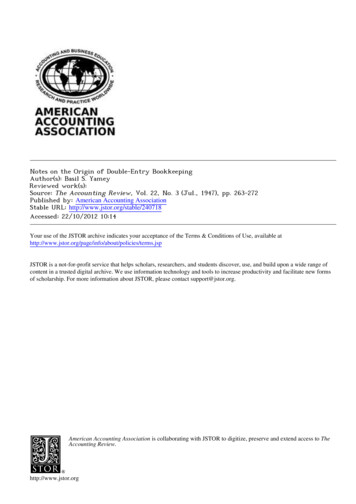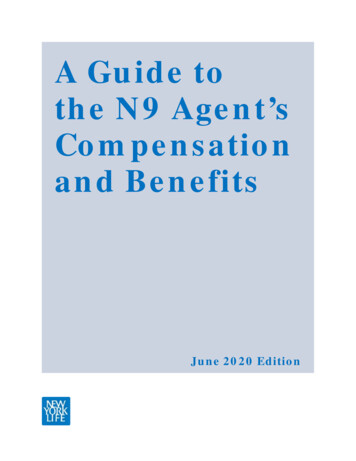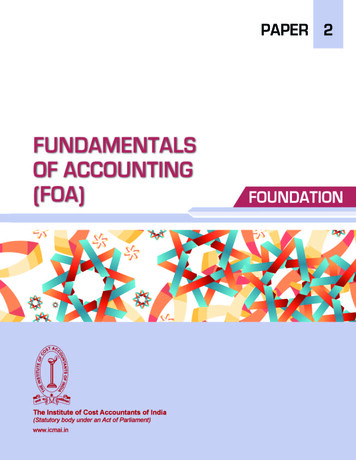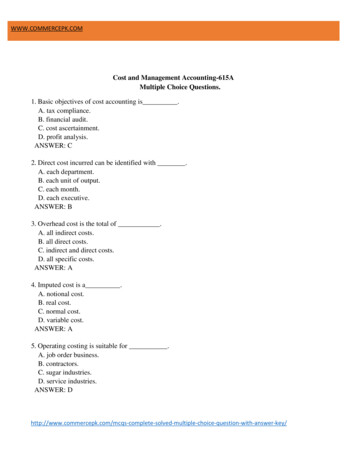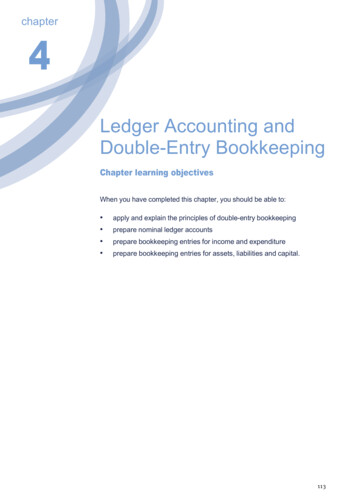
Transcription
chapter4Ledger Accounting andDouble Entry BookkeepingChapter learning objectivesWhen you have completed this chapter, you should be able to: apply and explain the principles of double entry bookkeepingprepare nominal ledger accountsprepare bookkeeping entries for income and expenditureprepare bookkeeping entries for assets, liabilities and capital.113
Ledger Accounting and Double-Entry Bookkeeping1 IntroductionIn this chapter we develop an understanding of: the principles of double entry bookkeepingthe preparation of nominal ledger accounts.2 Ledger accounts and the division of the ledgerIn most business entities each class of transaction and their associatedassets and liabilities are given their own account. For example, there will beseparate accounts for sales, purchases, rent, liabilities to pay suppliers(payables), amounts due from customers (receivables) etc. There is no ruleas to how many accounts an entity should have but the system shouldfacilitate effective and efficient accounting and control. Each account in thesystem is referred to as a 'ledger.'Ledger accounts – a definitionIn simple terms the ledger accounts are where the double entry recordsof all transactions and events are made. They are the principal books orfiles for recording and totalling monetary transactions by account. Anentity's financial statements are generated from summary totals in theledgers.114
chapter 4The term 'nominal ledger' or 'general ledger' is used to refer to the overallsystem of ledger accounts used within an entity. It houses all the separateledgers required to produce a complete trial balance and, consequently, setof financial statements.As stated above, each class of transaction, asset, liability and item of equitywill have its own ledger account. The summary of these ledger balances willeventually be transferred into the corresponding caption in the primaryfinancial statements. For a summary of the main classifications please referto the earlier chapters which explained the elements of the financialstatements and the classification of assets, liabilities, capital, income andexpense in a set of financial statements. Note also that books of prime entrywere covered in more detail in an earlier chapter. In this chapter we willfocus on the entries made in the ledger accounts. In particular we will look atthe nature of 'double entry' bookkeeping.3 Duality, double entry and the accounting equationEach transaction that an entity enters into affects the financial statements intwo ways.For example, an entity may buy a vehicle for cash. The two effects on theentity are:(1) it has increased the vehicle assets it has at its disposal for generatingincome, and(2) there is a decrease in cash available to the entity.115
Ledger Accounting and Double-Entry BookkeepingTo follow the rules of double entry bookkeeping, each time a transaction isrecorded, both effects must be taken into account. These two effects areequal and opposite and, as such, the accounting equation will always bemaintained.The accounting equationNote that the image above used the term 'equity' which is an alternative termto 'capital' when dealing with the accounting equation.The statement of financial position shows the position of an entity at onepoint in time. A statement of financial position will always satisfy theaccounting equation as shown above.The accounting equation is a simple expression of the fact that at any pointin time the assets of the entity will be equal to its liabilities plus its equity.Illustration 1 – The accounting equationThe transactions of a new business entity in its first five days are asfollows:Day 1Day 2Day 3Day 4Day 5AVO commenced business introducing 1,000 cash.Bought a motor car for 400 cash.Obtained a 1,000 loan.Purchased goods for 300 cash.Sold goods for 400 on credit.Required:Use the accounting equation to illustrate the position of the entity at theend of each day. (Ignore inventory for this example).116
chapter 4SolutionDay 1: AVO commenced business introducing 1,000 cashThe dual effect of this transaction is:(a) the entity has 1,000 of cash(b) the entity owes the owner 1,000 – this is capital/equity.Assets 1,000Equity 1,000Liabilities0Day 2: Bought a motor car for 400 cashThe dual effect of this transaction is:(a) the entity has an asset (a motor car) of 400(b) the entity has spent 400 in cashThis transaction changes the form in which the assets are held.Assets1,000400 – 400–––––1,000 Equity1,0000–––––1,000 Liabilities00–––––0Note that the acquiring of an asset must lead to one of the following: reducing another asset by a corresponding amount (as above)incurring a corresponding liabilityincreasing the equity of the owner (either capital invested or profitsmade and owed to the owners).117
Ledger Accounting and Double-Entry BookkeepingDay 3: Obtained a 1,000 loan from the bankThe dual effect of this transaction is:(a) the entity has 1,000 of cash(b) the entity owes 1,000 to the bank.Assets Equity1,0001,000–––––2,000 ��––1,000Day 4: Purchased goods for 300 cashThe purchase represents a cost (or an expense) to the entity. This costwill reduce the profits of the entity, which will in turn reduce equity.The dual effect of is:(a) The entity has an expense of 300 (expenses reduce the amountdue to the owners, i.e. they reduce equity)(b) The entity has reduced cash by 300.Assets Equity2,000(300)–––––1,700 �–––1,000Day 5: Sold goods for 400 on creditThe dual effect of this transaction is:(a) The entity has earned sales revenue of 400.(b) The entity has a new asset to receive payment of 400 from theircustomer.118
chapter 4The sales revenue will increase profits and will therefore increase equityin the business entity.Assets Equity1,700400–––––2,100 ��––1,0004 Ledger accounts, debits and creditsAn account is a record of the transactions involving a particular item.A ledger account may be thought of as a record kept as a page in a book.The book contains many pages – many accounts – and is referred to as aledger.In this chapter we are concerned with the nominal ledger, which is theledger containing all of the accounts necessary to summarise an entity’stransactions and prepare a statement of financial position and statement ofprofit or loss.Each account comprises two sides: the left hand side is referred to as thedebit side, and the right hand side is referred to as the credit side. Theformat is shown below:Debit (Dr)DateCredit (Cr)Details DateDetails Summary of steps to record a transaction(1) Identify the items that are affected.(2) Consider whether they are being increased or decreased.(3) Decide whether each account should be debited or credited.(4) Check that a debit entry and a credit entry have been made and theyare both for the same amount.119
Ledger Accounting and Double-Entry Bookkeeping Transactions and events are eventually recorded in the relevant ledgeraccounts using a double entry to reflect the duality concept explainedpreviously. There is a ledger account for each asset, liability, equity,income and expense item Traditionally each account was drawn as an enlarged 'T' that has twosides – a debit and a credit side as illustrated The duality concept means that each transaction will affect at least twoledger accounts One account will be debited and the other credited.Whether an entry is to the debit or credit side of an account depends onthe type of account and the transaction:DebitCreditIncrease in:Increase holder's equityYou can use the mnemonic 'PEARLS' to help you remember this vitallyimportant double entry rule.It is important to note that the opposite is also true; for example, a reductionin assets would constitute a credit entry into the ledgers.5 What is a ledger account?A ledger account is a record of the transactions involving a particular item.A ledger account may be thought of as a record kept as a page in a book.The book contains many pages – many accounts – and is referred to as aledger.In this chapter we are concerned with the nominal ledger, which is theledger containing all of the accounts necessary to summarise an entity'stransactions and prepare a statement of financial position and statement ofprofit or loss.Each account comprises two sides: the left hand side is referred to as thedebit side, and the right hand side is referred to as the credit side. Theformat is shown below:Debit (Dr)Date120Credit (Cr)Details DateDetails
chapter 46 What is double entry bookkeeping?According to the CIMA Official Terminology:Double entry bookkeeping: The most commonly used system ofbookkeeping based on the principle that every financial transaction involvesthe simultaneous receiving and giving of value, and is therefore recordedtwice.Duality conceptEarlier in this text we saw how some transactions affected theaccounting equation and the statement of financial position. We saw thateach transaction had two effects: this is referred to as the dual aspector duality concept. For example, receiving payment from a receivableincreases the asset ‘cash’, whilst also reducing the asset ‘receivables’;paying a supplier reduces the asset ‘cash’ whilst also reducing theliability ‘payables’; In both cases, the accounting equation remains intact.The fact that every transaction has two effects – equal and opposite –means that each transaction must be recorded in two ledger accounts.This is double entry bookkeeping.Bookkeeping is the technique of recording financial transactions as theyoccur so that summaries may be made of the transactions and presented asa report to the users of accounts. The double entry bookkeeping techniqueapplies to the recording of transactions in ledger accounts.Test your understanding 1Explain what is meant by the term ‘double entry bookkeeping’.In the previous chapters, you were introduced to the following terms: assetsliabilitiescapital/equityincome, andexpenses.121
Ledger Accounting and Double-Entry BookkeepingThese five items can be put into two categories, according to whetherthey appear in the statement of financial position or in the statement ofprofit or loss. Assets, liabilities and capital appear on the statement of financialposition. Expenses and revenue appear in the statement of profit or loss.If you compare these pairs you will see that they are, in effect, two pairs ofopposites.Each type of asset, liability, capital, expense or income is recordedseparately. This is achieved by using separate ledger accounts for each ofthem.7 Bookkeeping entries for the statement of financial positionWe shall look first of all at recording assets, liabilities and capital.Transactions are recorded on either the debit or the credit side of a ledgeraccount according to the following table:Debit (Dr)Credit (Cr)Increases in assetsDecreases in liabilitiesDecreases in capitalDecreases in assetsIncreases liabilitiesIncreases in capital/equityEntering transactions in ledger accounts is also called posting thetransactions.Examples of debit and credit entriesExamples of debit entries:122 Increase in assets, e.g. purchase of inventory, non current assets,increase in cash/bank Decreases in liabilities, e.g. payment of suppliers/loansDecreases in capital, e.g. drawings
chapter 4Examples of credit entries: Decrease in assets, e.g. sale of non current assets, payment ofreceivables, decreases in cash/bank Increases in liabilities, e.g. purchase of goods on credit, new loansobtained Increase in capital, e.g. introduce new capital into the entityIn chapter 2, we saw how transactions would affect the accounting equationand the statement of financial position. Worked Example 2.B from chapter 2which required you to determine the balance on Nadim's capital account at1 January is reproduced here as Worked Example 4.A of this chapter sothat the double entry bookkeeping entries (or postings) may be comparedwith the solution given in chapter 2.Worked Example 4.ANadim had the following assets and liabilities on 1 January:LandBuildingsInventoryReceivablesBank balanceCash in handPayablesBank loan ��——–Required:What was the balance of Nadim's capital account at 1 January?123
Ledger Accounting and Double-Entry BookkeepingSolution:First of all, we enter the opening balances into the ledger accounts. Assetshave debit balances, and liabilities and capital have credit balances.These balances are referred to as 'brought down' or 'brought forward' andare usually abbreviated to be shown as 'b/d', 'b/f' or 'b/fwd' on theappropriate side of the ledger.LandDr1 Jan Balance b/d Cr 200,000BuildingsDr1 Jan Balance b/d Cr 60,000InventoryDr1 Jan Balance b/d Cr 10,000ReceivablesDr1 Jan Balance b/d Cr 15,000Cash in handDr1 Jan Balance b/d Cr 5,000Bank balanceDr1 Jan Balance b/d124 32,000Cr
chapter 4PayablesDr Cr1 Jan Balance b/d 17,000Bank loanDr Cr1 Jan Balance b/d 240,000CapitalDr Cr1 Jan Balance b/d 65,000Note:(1) The capital account balance is the difference between assets andliabilities ( 322,000 – 257,000).Assume that Nadim had the following transactions during the first week ofJanuary:(1) Bought office equipment costing 7,000, paying 2,000 deposit bycheque, the balance to be paid at the end of March.(2) Returned some office equipment to his supplier because it was faulty.Nadim had originally been charged 3,000 for it.(3) Received 8,000 from his receivables. They all paid him by cheque.We now want to enter the January transactions into the ledger accounts.First, though, let us look at each transaction to determine how we are goingto record it.(1) Office equipment is an asset, and has increased. Therefore we want todebit the office equipment account.A cheque for 2,000 has been paid. The bank account, an asset, hasdecreased, so we want to credit the bank account with 2,000. Note that 5,000 is still owing to the supplier (payable), so liabilities need to beincreased, leading us to credit payables.125
Ledger Accounting and Double-Entry Bookkeeping(2) Office equipment has been returned, so the asset of office equipmenthas decreased. Therefore we want to credit the office equipmentaccount.As Nadim has not yet paid for the goods, this amount will be included in thepayables figure. If we return goods, the amount owed to payablesdecreases and, as payables are liabilities, we therefore want to debit thepayables account.(3) Receivables are assets. If they pay their debts, the amount oweddecreases, so we want to credit receivables.Bank is an asset. Paying money in increases the balance, so we want todebit bank.These transactions can now be entered into the ledger accounts, as follows:LandDr 1 Jan Balance b/dCr 200,000BuildingsDr1 Jan Balance b/dCr 60,000InventoryDr1 Jan Balance b/dCr 10,000ReceivablesDr1 Jan126 Balance b/dCr15,000 Jan Bank8,000
chapter 4Cash in handDr1 Jan Balance b/dCr 5,000Bank balanceDr 1 JanBalance b/dJanReceivablesCr32,000 Jan Office equip't2,0008,000PayablesDrJan Office equip'tCr3,000 1 JanJan Balance b/d17,000Office equip't5,000Bank loanDr Cr1 Jan Balance b/d240,000CapitalDr Cr1 Jan Balance b/d65,000Office equipmentDrJan CrBank2,000 JanPayables5,000 Payables3,000127
Ledger Accounting and Double-Entry Bookkeeping8 Bookkeeping entries for expenses and incomeAn expense is a cost connected with the day to day activities of the entity.Examples of expenses include rent, local business tax, light and heat,wages and salaries, postage, telephone i.e. costs of operating the businessentity, along with the cost of items bought for resale.Income is the term used to describe the activities that will eventually lead tothe entity receiving money. The most common source of income is thatderived from the sale of its goods or services, but others include the receiptof interest on bank deposits.Transactions are recorded on either the debit or the credit side of a ledgeraccount according to the following table:DebitCreditIncreases in expensesDecreases in incomeDecreases in expensesIncreases in incomeExamples of debit and credit entriesExamples of debit entries: Increases in expenses, e.g. purchase of materials, rent, wages,electricity costs Decreases in income, e.g. sales returnsExamples of credit entries: Decreases in expenses, e.g. purchase returnsIncreases in income, e.g. sales of goods for cash or credit9 Summary of bookkeeping entriesYou may find it easier to remember the mnemonic PEARLS to rememberthe debit and credit rule for transactions.Debit (Dr)Increase in128 Credit (Cr)Increase inPurchasesRevenue (income)ExpensesLiabilitiesAssetsShareholders' equity(capital)
chapter 4Summary of steps to record a transaction:(1) Identify the items that are affected.(2) Consider whether they are being increased or decreased.(3) Decide whether each account should be debited or credited.(4) Check that a debit entry and a credit entry have been made and theyare both for the same amount.Bookkeeping entries for purchases and salesWe keep separate ledger accounts for the different types of inventorymovement. Purchases and sales of inventory must always be kept inseparate accounts, because one is at cost price and the other at sellingprice. You might have difficulty in determining how to classify purchasesand sales. You could regard purchases as being assets, or you couldregard them as being expenses. It all depends on whether they areconsumed during the period, and that is unknown at the time they arebought. Similarly, sales could be regarded as decreases in inventory oras revenues. The fact is that it does not matter how you regard them.Both will result in the correct entry being made. For example, if youregard the purchase of inventory as an increase in an asset, you willmake a debit entry; if you regard it as an increase in an expense, you willstill make a debit entry. The same applies to sales – a decrease ininventory results in a credit entry, as does an increase in revenue. So,you will choose the right side for the entry, whichever way you classifythese. The most important thing is to use the correct account – and neveruse the inventory account for purchases and/or sales as the inventoryaccount is used only at the beginning and end of the accounting period.Also note that you should never use either the purchases account or thesales account for anything other than the goods in which the businessentity trades. Purchases of non current assets, stationery and so onshould all be recorded in their own ledger accounts.129
Ledger Accounting and Double-Entry BookkeepingTest your understanding 2Tick the correct box for each of the following:12345678Increases in assetsIncreases in liabilitiesIncreases in incomeDecreases in liabilitiesIncreases in expensesDecreases in assetsIncreases in capitalDecreases in incomeDebit.Credit.Illustration 2BR started a business on 1 May and, during the first month, entered intothe following transactions:1 May BR starts business as a sole proprietor with 20,000 incash2 May Pays 15,000 cash into a business bank account4 May Purchases goods on credit from JM for 2,0006 May Purchases goods from ERD on credit for 3,0007 May Pays wages in cash 6010 May Pays rent by cheque 8012 May Sells goods for cash 21016 May Buys furniture for 1,500 paying by cheque19 May Sells goods on credit to SP for 58022 May Buys goods for cash 3,90024 May Buys fittings for cash 600Pays carriage outwards costs by cheque 2525 May Pays wages by cash 110Sells goods for cash 43027 May Receives part payment from SP of 330 by chequePays carriage inwards costs by cheque 2028 May Pays advertising by cheque 25Sells goods for cash 89029 May Sells goods on credit to KM for 8,09030 May Withdraws 100 cash for his personal use130
chapter 4Required:Prepare ledger account entries to record the transactions.Note: When you draw up your accounts, you may want to leave extralines after the bank account (approx 10), and after all other ledgeraccounts (approx 4 per account) – this exercise is continued in chapter5.Note: It might help you to determine the correct ledger entries bycompleting a table before you start, like this (the first item is done foryou):DateNames ofaccountsinvolvedType of Increase/decrease talCapitalIncreaseCreditSolutionCapitalDr Cr1 MayDr1 May12 May25 May28 MayDr2 May27 MayCapitalSalesSalesSalesCash Cr20,000 2 May210 7 May430 22 May890 24 May25 May30 MayCashSPBank Cr15,000 10 May330 16 May24 May27 May28 May nitureCarriage outCarriage inAdvertising20,000 15,000603,900600110100 801,500252025131
Ledger Accounting and Double-Entry BookkeepingPurchasesDrCr 4 MayJM2,0006 MayERD3,00022 MayCash3,900JMDrCr4 May Purchases2,000ERDDrCr6 May Purchases3,000WagesDr Cr7 MayCash6025 MayCash110RentDr10 May CrBank80SalesDrCr 12 MayCash21019 MaySP58025 MayCash43028 MayCash89029 MayKM8,090FurnitureDr16 MayCr Bank1,500SPDr19 May132 SalesCr580 27 May Bank330
chapter 4FittingsDrCr 24 MayCash600AdvertisingDr Cr28 MayBank25KMDr 29 MaySalesCr8,090DrawingsDr Cr30 MayCash100Carriage OutwardsDr Cr24 MayBank25Carriage InwardsDr Cr27 MayBank20Test your understanding 3ATH commenced business on 1 February 20X1, paying 500 into abusiness bank account.During the next month the following transactions took place. All paymentsare made by cheque and all receipts are banked. 1 Feb5 Feb10 Feb22 Feb26 Feb27 FebBought goods for resalePaid rentSales receiptsPaid for advertisingATH's drawingsSales receipts1505029025100240133
Ledger Accounting and Double-Entry BookkeepingRequired:(a) write up the bank account(b) write up all the other accounts.Note: When you draw up your accounts, leave ten extra lines after thebank account, and four extra lines after all other ledger accounts – thisexercise is continued in chapter 5.Ledger account entries from day booksMaking the ledger account entries from day booksExamples within this chapter have recorded the double entries requiredto record individual transactions. Chapter 3 dealt with the recording orlisting of transactions in day books so that they can be periodicallytotalled and summarised for posting into the nominal ledger.Here, the accounting entries required to record transactions listed in theday books from Worked Example 3.A in chapter 3 are stated. Youshould note that, whether individual transactions are posted, or whethertransactions are first listed and totalled in a book of prime entry prior toposting in the nominal ledger, exactly the same principles of double entryapply.134Purchase day bookDebitPurchases accountDebitSales taxCreditPurchase ledger control account 1,600Sales day bookDebitCreditCredit 1,520Sales ledger control accountSales taxSales account1,6001,520Returns in day bookDebitReturns inwards accountCreditSales ledger control account 320320Returns out day bookDebitPurchase ledger control accountCreditReturns outwards account 200200
chapter 4Note that the sales and purchases control accounts only show the total oftransactions relevant for each control account. They will not identifyseparate amounts due to each credit supplier or due from each creditcustomer. Therefore there is a need to maintain a separate set of ledgeraccount balances for individual credit suppliers (in a purchase ledger)and individual credit customers (in a sales ledger). Note that the salesledger and purchase ledger balances are not part of the double entryaccounting system they are memorandum accounts only to help theentity manage and control its accounting transactions.Consequently, the recording of accounting transactions can be dividedup and allocated between a number of employees, each having distinctresponsibilities. This is particularly important in larger entities where, forexample, a different person may have sole responsibility for each of thefollowing: cash receipts bookcash payments booksales ledgerpurchase ledgergeneral or nominal ledgerNominal ledger accountsAt this stage in your studies, all your ledger accounts are kept in a single‘book’. In later chapters you will see how the ledger accounts can be dividedinto several books. The main book used is called the nominal ledger.135
Ledger Accounting and Double-Entry Bookkeeping10 Chapter summaryIn this chapter you have studied: how financial transactions are recorded in ledger accounts, usingdouble entry principles.Double entry is the cornerstone of the entire accounting process. You will notget far in your studies of this subject unless you have a thorough grasp of itsprinciples. Make sure you can follow the steps involved in the examplesgiven in this chapter, and memorise the table:It is important that you fully understand the double entry system, as it willenable you to understand how to record more complex transactions later onin your studies.Try not to analyse the reason for the ‘left and right’ system for recordingtransactions. It is simply a rule that, if everyone abides by it, leads to acommon system. It can be likened to the rule for driving a car. If the rule in acountry is to drive on the left, then the system works as long as everyoneabides by the rule.Practise the examples in the chapter several times until you feel competentin them.136
chapter 4Test your understanding questionsTest your understanding 4Which one of the following statements is correct?AAssets and liabilities have credit balancesBLiabilities and revenues have debit balancesCAssets and revenues have credit balancesDAssets and expenses have debit balancesTest your understanding 5ALC had the following assets and liabilities at 1 January: 350700400125880InventoryPayablesReceivablesBank overdraftMotor vehiclesRequired:What was the capital account balance at 1 January? .Test your understanding 6The correct entries needed to record the return of office equipment thathad been bought on credit from PYO, and not yet paid for, are:DebitCreditAOffice equipmentSalesBOffice equipmentPYOCPYOOffice equipmentDCashOffice equipment137
Ledger Accounting and Double-Entry BookkeepingTest your understanding 7Which of the following is the correct entry to record the purchase oncredit of inventory intended for yableCPurchasesPayableDPayablePurchasesTest your understanding 8A receives goods from B on credit terms and A subsequently pays bycheque. A then discovers that the goods are faulty and cancels thecheque before it is cashed by B. How should A record the cancellation ofthe cheque in his books.138DebitCreditAPayablesReturns outwardsBPayablesBankCBankPayablesDReturns outwardsPayables
chapter 4Test your understanding 9The table below shows a selection of financial transactions. Completethe columns to identify the accounts and the debit/credit entries to bemade in the ledger to record each of the transactions.Transaction descriptionAccount to bedebitedAccount to becredited1 Sold goods on credit to BAS2 Bought goods for sale oncredit from PWA3 Returned goods to PWA4 Bought office machinery oncredit from WPR5 Returned office machinery toWPR6 Received cash from PWR7 Received payment from TWIby cheque8 Owner’s private car broughtinto the business9 Cheque received from PWRdishonouredTest your understanding 10The double entry system of bookkeeping normally results in which of thefollowing balances in the ledger accounts?DebitCreditA Assets and incomeLiabilities, capital and expensesB Income, capital and liabilitiesC Assets and expensesAssets and expensesD Assets, expenses and capitalLiabilities and incomeLiabilities, capital and income139
Ledger Accounting and Double-Entry BookkeepingTest your understanding 11What double entry should be made with the totals from the sales returnsday book?ABCDDrCrDrCrDrCrDrCrReceivablesReturns inwardsReturns inwardsReceivablesReturns inwardsPayablesReturns outwardsPayablesTest your understanding 12The cash payments bookThe following is the cash payments book of a small printing 7.X6MRAOfficeMRBMRCShopBank 1,4003,0002101,600400–––––6,610Discount 100Payables 1,400Rent 400–––––3,400Required:What are the accounting entries arising from the totals in the cash bookat the end of the day, assuming control accounts are kept?140
chapter 4Test your understanding 13The following is the cash receipts book of the SMA art gallery.DateDetail18.7.X6 C Monet18.7.X6 InterestAcc # 118.7.X6 V V Gogh18.7.X6 InterestAcc # 218.7.X6 P PicassoBankreceived 10,00020Discount 500Bankinterest 2025,00010013,700––––––48,820Receiv ables �––48,700––––120Required:What are the accounting entries arising from the totals in the cash bookat the end of the day, assuming that individual accounts for eachcustomer and supplier are maintained?Test your understanding 14NRA keeps cash and bank records. At the close of business on 29 May20X1 he reached the bottom of a page and carried forward thefollowing:Discount( )Cash( )Bank( )Total b/f27.40114.10214.30Debit sideTotal b/f40.1074.50210.00Credit sideThe following sums were received on 30 May 20X1:Cheque from JCC for 120 in settlement of an account for 125Cash from NGR 40Cheque from XYZ for 75 in settlement of an account for 76.50141
Ledger Accounting and Double-Entry BookkeepingThe following payments were made on 30 May 20X1:Cheque to MBR for 140.40Cheque to local council in payment of local business tax for the half year 150.40NRA cashed a cheque for private drawings of 50 and took anadditional 50 from the office cash for the same purpose.Required:Write up NRA's cash and bank records on 30 May 20X1.Test your understanding 15SMA commenced in business as a decorator on 1 January.1 Jan C
1 Introduction In this chapter we develop an understanding of: the principles of double entry bookkeeping the preparation of nominal ledger accounts. 2 Ledger accounts and the division of the ledger In most busines

